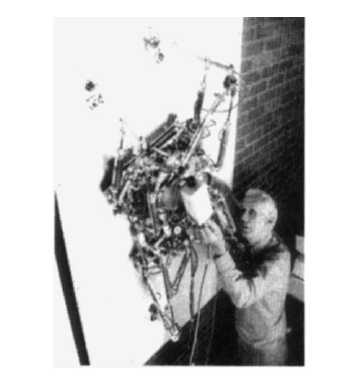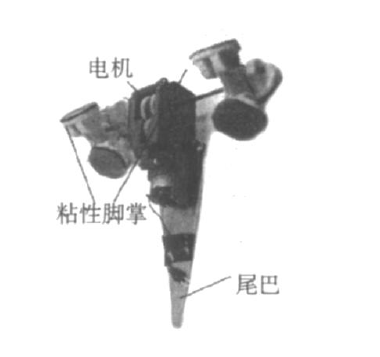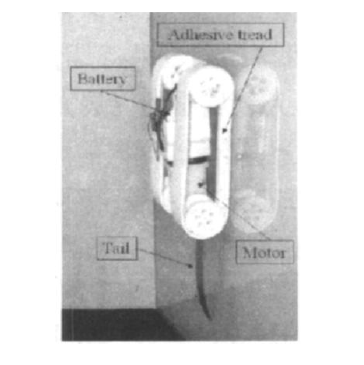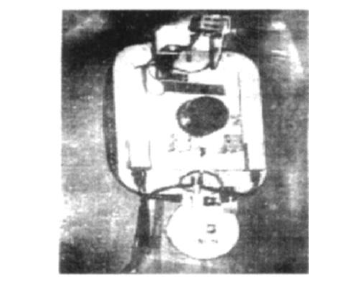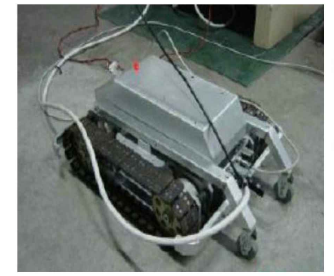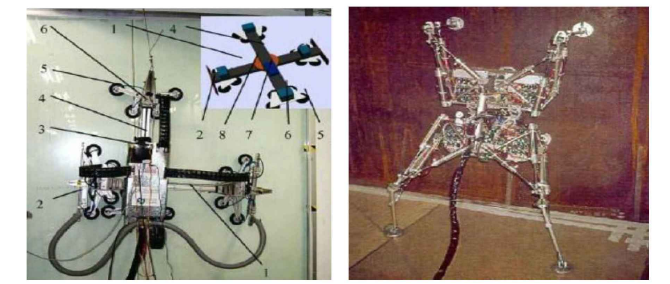在役油罐内壁除锈用爬壁机器人本体设计毕业论文
2020-04-10 16:00:59
摘 要
随着环境保护的呼声越来越高,石化行业对储油储气罐的规范也越来越严密,需要定期对在役油罐进行检测、清洗、除锈等维护保养工作。但是在役油罐工作时处于密闭状态,存在大量的易燃易爆介质,且氧气含量极低,因此若是人工进入工作需要前期大量的准备工作且极其不安全。因此,本课题拟研制一款作用于在役油罐内壁除锈用的爬壁机器人代替工人进入在役油罐工作。在役油罐内壁除锈用爬壁机器人的本体机构主要由三部分构成——移动机构、吸附机构、驱动系统,本文主要围绕着这三部分主要机构展开深入研究,确定其构成主要方式。论文主要研究内容如下:
根据目前普遍使用的油罐对机器人特定的尺寸,移动方式,工作方式等进行改进优化。首先,机器人在油罐内壁移动方式由周向和轴向两种移动方式合成,其运行轨迹在油罐圆柱面大致为一条等距螺旋线。周向运动采用链传动式履带移动装置,其重点工作之一就是确定链轮的齿数以及链轮之间的距离。轴向运动机构由转向轮和差速电机配套组成。根据我们的设计方式,周向运动和轴向运动不能同时作用,因此在工作时,我们需要一个顶升机构使转向轮脱离工作壁面。其次,在履带单个组成元件上面嵌入永磁吸附模块作为吸附装置,并对吸附装置进行优化分析,计算得出最佳的气隙、高度以及吸附力。然后在移动装置和吸附装置的基础之上进一步研究驱动机构,驱动机构又分为两部分,即为克服机器人前后移动阻力的移动驱动系统和为机器人转向所需要克服横向摩擦力提的转向驱动系统。移动驱动系统我们主要研究了油罐横截面的三个关键点所需要的驱动力矩大小,即两个竖直点和顶点。转向驱动系统主要研究了摩擦力以及重力的分力对转向的影响。
在确定各装置以及系统所采用的的基本方案后,我们再对各个部分进行深入细致的研究优化,确保能够在不同尺寸,不同环境的油罐中良好的完成除锈等预定工作。最后我们根据三部分的相互关联,将其整合成一个整体机构,即油罐内壁除锈用机器人本体机构。 为以后相关的爬壁机器人本体研究提供了一定的理论基础。
关键词:在役油罐,链传动,履带式爬壁机器人,永磁吸附单元,除锈,整体机构
ABSTRACT
With the growing demand for environmental protection, the petrochemical industry has become more and more rigorous in the specification of oil storage and gas storage tanks. It is necessary to periodically perform inspections, cleaning, and rust removal on maintenance tanks in service. However, the oil tanks in service are in a closed state, there are a large number of flammable and explosive materials, and the oxygen content is extremely low. Therefore, if manual entry into the work requires a lot of preparatory work and is extremely unsafe. Therefore, this project intends to develop a wall-climbing robot that acts on the derusting of the inner wall of oil tanks in service to replace the workers in the oil tanks in service. The body mechanism of the wall-climbing robot used to remove rust on the inner wall of oil tanks is mainly composed of three parts—a moving mechanism, an adsorption mechanism, and a drive system. This paper mainly focuses on the three main bodies and conducts in-depth research to determine the main methods of its construction. The main research contents of the paper are as follows:
According to the commonly used oil tanks, the robot's specific dimensions, movement methods, and working methods are improved and optimized. First of all, the movement of the robot on the inner wall of the oil tank is composed of two movement modes: the circumferential direction and the axial direction. The trajectory of the robot is roughly an equidistant spiral line on the cylindrical surface of the oil tank. One of the key tasks in the use of chain-driven tracked mobile devices for circumferential movement is to determine the number of teeth on the sprocket and the distance between the sprocket. The axial movement mechanism consists of a steering wheel and a differential motor. According to our design method, the circumferential movement and the axial movement can not act at the same time, so during the work, we need a lifting mechanism to make the steering wheel out of the working wall. Secondly, a permanent magnet adsorption module is embedded on the individual components of the crawler as an adsorption device, and the adsorption device is optimized for analysis, and the best air gap, height and adsorption force are calculated. Then, the drive mechanism is further studied on the basis of the mobile device and the adsorption device. The drive mechanism is further divided into two parts, namely a mobile drive system that overcomes the forward and backward movement resistance of the robot and a steering drive system that needs to overcome the lateral friction force for the robot steering. . Mobile Drive System We mainly studied the required drive torque for the three key points of the tank cross-section, ie, two vertical points and vertices. The steering drive system mainly studies the influence of friction force and the force component of gravity on the steering.
After confirming the basic scheme adopted by each device and system, we will conduct in-depth and detailed research and optimization of each part to ensure that the scheduled work such as rust removal can be performed well in oil tanks of different sizes and environments. Finally, according to the interrelationship of the three parts, we integrated it into a whole body, that is, the robot body mechanism for derusting the inner wall of the tank. It provides a certain theoretical basis for the related research of the climbing wall robot.
Key words: In-service tank, chain drive, tracked wall climbing robot, permanent magnet adsorption unit, derusting, integral mechanism
目 录
第1章 绪论 1
1.1 选题的来源、背景及意义 1
1.1.1 选题的来源 1
1.1.2 选题的背景 1
1.1.3 选题的意义 2
1.2 爬壁机器人的应用领域及分类特点 2
1.2.1 应用领域 2
1.2.2 分类特点 2
1.3 国内外发展状况 3
1.3.1 爬壁机器人国外发展状况 3
1.3.2 爬壁机器人国内研究现状 7
1.4 本文主要研究内容 9
1.4.1 技术方法路线 9
1.4.2 技术指标 10
1.5 本章小结 11
第2章 爬壁机器人移动机构设计 12
2.1几种移动机构综述 12
2.1.1 移动机构的比较 12
2.1.2 除锈机器人油罐内部运行方式 12
2.1.3 移动机构的选折 12
2.2 除锈机器人履带行走装置设计 13
2.2.1 链传动的特点和应用 13
2.2.2 链传动主要参数的确定 14
2.3 本章小结 16
第3章 爬壁机器人吸附机构设计 17
3.1 吸附机构选折 17
3.1.1 几种吸附机构的优缺点介绍 17
3.1.2 爬壁机器人吸附机构的选取 17
3.2 双稳态永磁吸附装置设计优化 19
3.2.1 几种常见的磁性材料 19
3.2.2 永磁材料 19
3.2.3 磁性材料的选折 21
3.3 磁吸附力的定量计算 21
3.4 本章小结 22
第4章 爬壁机器人驱动系统设计 23
4.1 驱动方式选择 23
4.2 驱动转矩确定 24
4.2.1 机器人处于竖直平面电机转矩确定 24
4.2.2 机器人悬于水平面转矩确定 25
4.2.3 转矩确定 25
4.3 转向调节机构 26
4.3.1 转向方式选折 26
4.3.2 转向受力分析 27
4.3.3 转向驱动力 28
4.4 本章小结 29
第5章 总结与展望 30
参考文献 31
致谢 33
第1章 绪论
1.1 选题的来源、背景及意义
1.1.1 选题的来源
在石化企业中,油罐作为存储设备广泛应用于石化能源的存储,运输。由于油品和雨水等易氧化物质的侵蚀,油罐内壁容易氧化锈蚀。内壁氧化锈蚀不仅会污染所存储的油料,甚至可能引发安全事故。因此油罐内部的定期检测、除锈等工作对于安全生产就显得尤为重要。目前,油罐内壁的检测除锈均由人工手动实现,对人生安全会有重大隐患且效率很低。随着石化工业的迅速发展,企业对在役油罐除锈的效率要求越来越高,研制自动化除锈设备的呼声也越来越高。鉴于油罐内壁除锈任务的特点,自动化除锈系统需要着重解决以下的几点关键技术:
(1)研究可靠的载体机器人,按照设定的工作模式携带除锈喷头在油管内壁正常工作,保证工作效率和质量。
(2)整个机器人系统体积小巧,能够从油罐开口进入内部工作。
(3)机器人所携带的除锈喷头不能对油罐内壁造成损伤,但同时又要达到除锈要求。
本课题研究的在役油罐内壁除锈用爬壁机器人就是为了代替工作人员直接面对危险环境工作,保证工作人员的生命安全,对油罐内壁更高效率的除锈作业。
1.1.2 选题的背景
爬壁机器人按照工作特点定义属于特种工业机器人,其宗旨是在极限、高危、恶劣的工作环境下,出于保护工人人生安全的目的设计的一种进行特定作业的自动化机器人。工作范围包括危化品检测处理,危险环境的探测,狭小环境的工作等。目前,爬壁机器人已经广泛应用在核工业,石化行业,造船行业等行业的生产施工中,并且应用率逐年升高。
爬壁机器由于工作环境的独特性,应当具备以下几个特点:
(1)在特定工作壁面上的移动功能。不同于一般的机器人,爬壁机器人必须在特定的工作壁面上工作,因此需要比较好的运动能力,例如越障,工作壁面之间的转换等。
(2)在特定工作壁面上的吸附功能。爬壁机器人不同于平地工作的机器人,还需要一个独特的吸附装置保证爬壁机器人能够良好的在各种倾斜平面或者大倾角平面上工作。
因为爬壁机器人工作时受力关系在不断变化,为了保证良好的移动性能,我们就需要确定其吸附力与负载之间的关系。众所周知,对于爬壁机器人,负载越重,所需要的吸附能力就要越强,而吸附能力越强,就要求移动时克服吸附阻力做工越多,因此驱动功率就要越大,然而驱动系统又反过来使得负载更大 [1]。所以我们应该对于特定的机器人要找到一个合适吸附力和驱动功率,保证移动机构的灵活性又满足其吸附能力。
爬壁机器人按吸附方式的不同可分为磁吸附、真空吸附、推力吸附等方式。他们在不同的领域都有很广泛的应用。磁吸附方式结构比较简单,对工作壁面的平整度要求比较低,吸附力远大于真空吸附方式所产生的吸附力,但对吸附平面材质的要求单一,即必须是导磁材料,因此对机器人的工作场合要求非常高。真空吸附方式对爬壁机器人的工作壁面材料性质无特定要求,并且吸附力比较低,因此适用于负载比较低的小型爬壁机器人。推力吸附方式结构比较复杂,吸附力比较高,对工作壁面限制比较低,但是会导致机器人体积过大。

 :
:
(1)电缆供给方式多作用于需要长时间工作的机器人,并且要求工作轨迹非常单一,防止电缆缠绕打结。然而,电缆使得机器人的移动不方便,并且对工作的灵活性有很大影响[2]。 容易漏电,危险性很高。
容易漏电,危险性很高。
(2)蓄电池供电方式能够有效解决电缆供给方式的一系列缺点。但是它体积大,质量重,并且供电时间有限等限制了蓄电池供电方式的发展。
1.1.3 选题的意义
爬壁机器人广泛应用于消防部门,急救,清洁,检测和测试行业。能有效降低员工的劳动强度和危险程度,提高工作效率,因此爬壁机器人近几年得到广泛推广。对于在役油罐而言,为了使油气储运更加安全环保,需要频繁的对油罐内壁进行安全检测,维修等工作。因为油罐是密闭空间,存在大量的易燃易爆物质且工作过程中容易产生有毒物质,对工作人员存在较高的安全风险。因此研制一款能够用于在役油罐内壁检测维修的爬壁机器人来代替工作人员直接在油罐内壁工作就显得尤为迫切。
1.2 爬壁机器人的应用领域及分类特点
1.2.1 应用领域
爬壁机器人主要应用于:(1)核工业:对高辐射区域进行射线检测,核废料储存罐进行视觉检测,维护、维修等。(2)石油化工企业:对油料储液罐或输送管道的内外壁进行检查或清洗、除锈。(3)建筑行业:对于摩天大楼的幕墙外壁面清洗作业,高层的检测作业等(4)消防部门:危险、狭小空间的环境探测,救援信息的传递,救援物资的运输等。(5)造船业:船舶船体内外壁的喷涂,除锈,清洗。(6)军事或警用:反恐检查,危险物品的专业,排爆,隔离等。(7)航空航天业:对航空航天设备的精密检查。
1.2.2 分类特点
爬壁机器人根据移动方式可分为:
(1)机械夹持:断电时吸附仍然稳定,需要特定调整对于某些建筑物。
(2)车轮式吸附:控制简单灵活,越障能力较差,吸附力比较小。
(3)履带式吸附:与避免接触面较大,因而吸附力较大,有一定的越障能力,对壁面材料要求单一
(4)脚足式吸附:越障能力很强,移动速度慢,较难控制。适合多壁面之间频繁移动移动的工作场合。
爬壁机器人根据吸附方式可分为:
(1)真空吸附:对爬壁机器人工作壁面材料性质无特殊要求,但是对吸附壁面要求较高。
(2)磁吸附:吸附力大,对壁面凹凸适应性强,但是只能作用于导磁材料壁面。
以上是毕业论文大纲或资料介绍,该课题完整毕业论文、开题报告、任务书、程序设计、图纸设计等资料请添加微信获取,微信号:bysjorg。
相关图片展示:
